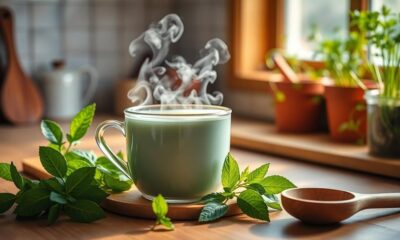Oolong Tea
How To Grow Oolong Tea

Cultivating oolong tea can be a gratifying experience, albeit demanding some understanding and perseverance. Below you’ll find a detailed guide aimed at assisting you in the growth and collection of your very own oolong tea:
-
Select the right variety: Choose a variety of oolong tea that is suitable for your climate and growing conditions. Some popular varieties include Tie Guan Yin, Da Hong Pao, and Oriental Beauty.
-
Prepare the soil: Oolong tea plants thrive in well-draining soil with a pH level between 5.5 and 6.5. Prepare the soil by adding organic matter such as compost or aged manure to improve its fertility and drainage.
-
Choose a suitable location: Oolong tea plants prefer partial shade, so choose a location in your garden that receives a few hours of sunlight each day. Avoid areas with strong winds or extreme temperatures.
-
Plant the tea seeds or cuttings: Oolong tea can be grown from seeds or cuttings. If you choose to grow from seeds, soak them in water for 24 hours before planting. Plant the seeds or cuttings in well-prepared soil, ensuring they are spaced at least 3 feet apart.
-
Water and fertilize: Oolong tea plants require regular watering, especially during dry periods. Water the plants deeply, ensuring the soil is moist but not waterlogged. Fertilize the plants with a balanced organic fertilizer every 4-6 weeks during the growing season.
-
Prune and train the plants: As the oolong tea plants grow, prune them to promote bushier growth and remove any dead or diseased branches. You can also train the plants to grow in a specific shape or form by using stakes or trellises.
-
Harvest the leaves: Oolong tea leaves are typically harvested when they are young and tender. This usually occurs in the spring or early summer. Pluck the top two leaves and the bud from each branch, being careful not to damage the plant.
-
Process the leaves: After harvesting, the leaves need to be processed to bring out their unique flavors. This can involve withering, rolling, oxidizing, and drying the leaves. The exact process will depend on the type of oolong tea you are making.
-
Store and enjoy: Once the leaves are processed, store them in airtight containers away from light, heat, and moisture. This will help preserve their freshness and flavor. When you’re ready to enjoy your oolong tea, steep the leaves in hot water for a few minutes and savor the aromatic and flavorful cup of liquid gold you have grown yourself.
Growing oolong tea is a journey that requires dedication and care, but the rewards are well worth it. So, why not give it a try and create your own garden oasis filled with the aroma of freshly brewed oolong tea?
Key Takeaways
- Use natural pest control methods like neem oil and ladybugs to deter pests and prevent diseases in oolong tea plants.
- Harvest tea leaves at the right time, picking the young and tender leaves with a vibrant green color and smooth texture.
- Properly process the tea leaves, controlling oxidation levels to achieve the desired flavor profile of oolong tea.
- Store oolong tea in an airtight container, away from strong odors and moisture, to maintain its freshness and quality.
Choose the Right Variety of Oolong Tea
Before you start growing oolong tea, make sure you choose the right variety that suits your climate and preferences.
There are numerous varieties of oolong tea available, each with its unique flavor profile and brewing characteristics. Some popular varieties include Tie Guan Yin, Da Hong Pao, and Oriental Beauty.
It’s important to research and understand the specific requirements of each variety before making your selection. Additionally, consider the brewing techniques that are traditionally associated with each type of oolong tea. This will ensure that you can fully appreciate the flavors and aromas of your homegrown tea.
Once you have chosen the right variety, you can move on to the next step: preparing the soil and planting the tea seedlings.
Prepare the Soil and Plant the Tea Seedlings
First, ensure that the soil is properly prepared and the tea seedlings are planted. Here’s a step-by-step guide to help you with soil preparation and seedling planting:
-
Test the soil: Before planting, it’s essential to test the soil’s pH level and nutrient content. Oolong tea prefers slightly acidic soil with a pH range of 6 to 6.5.
-
Amend the soil: If the soil pH is too high, you can lower it by adding organic matter like peat moss or compost. Incorporate these amendments into the soil to improve its structure and drainage.
-
Choose the right location: Oolong tea thrives in areas with partial shade. Find a spot that receives morning sunlight and afternoon shade to provide the ideal growing conditions for the tea plants.
-
Plant the seedlings: Dig a hole that is slightly larger than the root ball of the seedling. Place the seedling in the hole and backfill with the amended soil. Gently press the soil around the seedling to secure it.
Now that the seedlings are planted, we can move on to the next step of providing adequate sunlight and water for their growth.
Provide Adequate Sunlight and Water
Now that the seedlings are in the ground, how can we ensure they receive the right amount of sunlight and water for their development?
Oolong tea plants have specific sunlight requirements that must be met to ensure their optimal growth. These plants thrive in partial shade, so it is important to provide them with filtered sunlight or shade during the hottest parts of the day. This can be achieved by planting them under taller trees or using shade cloth.
In terms of watering, oolong tea plants prefer a consistent moisture level in the soil. It’s best to water them deeply but infrequently, allowing the soil to dry out slightly between waterings. This helps promote deep root growth and prevents overwatering.
As we move on to the next step of pruning and shaping the tea plants, it is crucial to maintain the right balance of sunlight and water for their overall health and productivity.
Prune and Shape the Tea Plants
To ensure healthy development and maximize productivity, it’s important to carefully prune and shape your tea plants. Pruning techniques play a crucial role in maintaining the overall health and vigor of the plants.
Regular pruning helps remove dead or diseased branches, allowing for better air circulation and reducing the risk of pests and diseases. It also stimulates new growth and promotes the production of high-quality leaves.
When pruning oolong tea plants, it’s important to use sharp, clean pruning shears and make precise cuts just above a leaf node. This encourages lateral branching and ensures a well-shaped plant.
Additionally, shaping methods such as topping and pinching can be employed to control the height and width of the plants, making harvesting easier.
With well-pruned and properly shaped tea plants, you’ll be ready to move on to the next step of applying fertilizer and mulch, which further enhances their growth and productivity.
Apply Fertilizer and Mulch
For optimal growth and bountiful harvests, make sure to nourish your tea plants with fertilizer and protect them with a layer of mulch. Think of mulch as a nutrient-rich blanket that keeps your plants cozy and well-fed. Here are some techniques for applying fertilizer to your oolong tea plants:
- Use a balanced fertilizer with higher nitrogen content during the growing season.
- Apply the fertilizer evenly around the base of the plants, avoiding direct contact with the stems.
- Water the plants after fertilizing to help the nutrients penetrate the soil.
- Repeat the fertilizer application every four to six weeks during the growing season.
- Adjust the fertilizer dosage based on the health and growth of your tea plants.
Using mulch offers several benefits to your tea plants:
- Retaining soil moisture, reducing the need for frequent watering.
- Suppressing weed growth, preventing competition for nutrients.
- Insulating the roots, protecting them from extreme temperatures.
- Improving soil structure and fertility over time.
- Enhancing the overall health and vigor of your tea plants.
By nourishing your tea plants with fertilizer and providing them with a protective layer of mulch, you are ensuring their well-being and setting the stage for a successful harvest. As we move on to the next section about protecting the tea plants from pests and diseases, it is crucial to maintain a healthy foundation.
Protect the Tea Plants from Pests and Diseases
To protect your tea plants from pests and diseases, it is important to implement integrated pest management. This approach allows you to control pests effectively while minimizing the use of harmful chemicals. Natural remedies like neem oil can be used to deter common tea plant pests such as aphids, mites, and caterpillars. Introducing beneficial insects like ladybugs can also help control their populations. Regularly inspect your plants for signs of disease, such as leaf spots or mold, and address any issues promptly. Proper sanitation, including removing fallen leaves and keeping the growing area clean, is also crucial. By following these practices, you can protect your tea plants and maximize their growth potential.
Moving forward, understanding how to harvest the tea leaves at the right time is important.
Harvest the Tea Leaves at the Right Time
Harvesting the tea leaves at the right time allows for the full flavor and aroma to develop, creating a truly satisfying and memorable tea experience. To ensure you harvest your oolong tea leaves at their peak, here are some tips:
-
Best time: The ideal time to harvest oolong tea leaves is when they are young and tender, usually in the early morning or late afternoon. This is when the flavor is at its best.
-
Leaf appearance: Look for leaves that are a vibrant green color and have a smooth texture. Avoid leaves that are wilted or damaged.
-
Two leaves and a bud: When plucking the leaves, aim to pick the top two leaves and the bud. These young leaves contain the highest concentration of flavor compounds.
By following these tips, you can ensure that you harvest the best quality leaves for your oolong tea. Once harvested, it’s time to process the leaves to create oolong tea, which involves a series of carefully controlled steps.
Process the Leaves to Create Oolong Tea
After harvesting the tea leaves at the right time, it is crucial to process them properly in order to create high-quality oolong tea. The processing techniques play a significant role in bringing out the unique flavors and aromas of this exquisite tea.
One key step in the processing is tea oxidation, where the leaves are intentionally exposed to air to initiate a natural chemical reaction. This reaction alters the flavor profile of the tea, resulting in a balanced and complex taste. The level of oxidation can vary depending on the desired oolong tea style, ranging from lightly oxidized to heavily oxidized. By carefully controlling the oxidation process, tea artisans can bring out the best characteristics of the leaves.
With the leaves properly processed, it is now time to move on to the next step: storing and aging the oolong tea properly.
Store and Age the Oolong Tea Properly
To properly preserve and enhance the flavors of your exquisite oolong tea, it is essential that you master the art of storing and aging.
Proper storage techniques play a crucial role in maintaining the quality and freshness of your tea. First, make sure to store your oolong tea in an airtight container, away from strong odors and moisture. This will prevent the tea from absorbing any unwanted flavors or moisture that can affect its taste. Additionally, keep your tea away from direct sunlight or heat sources to avoid any damage.
Now, let’s talk about the benefits of aging oolong tea. Aging your tea allows it to develop more complex flavors and aromas over time. The natural chemical changes that occur during the aging process create a smoother and richer taste.
As you master the art of storing and aging, you’ll soon be able to enjoy the delightful flavors of your homegrown oolong tea.
Enjoy Your Homegrown Oolong Tea
Savor the exquisite flavors of your own homegrown oolong tea, indulging in its aromatic richness and delicate complexities.
There are numerous benefits to growing your own oolong tea at home. Not only does it provide a sense of satisfaction and pride, but it also ensures that you have access to the freshest and highest quality tea leaves.
Homegrown oolong tea is rich in antioxidants, which can boost your immune system and promote overall health. Additionally, by growing your own tea, you have the freedom to experiment with different DIY oolong tea recipes. You can create unique blends by combining different herbs, fruits, or flowers to enhance the flavors of your tea.
So, embrace the art of growing oolong tea at home and unlock a world of delightful flavors and wellness benefits.
Frequently Asked Questions
Can oolong tea be grown indoors?
Yes, oolong tea can be grown indoors through indoor gardening techniques like container planting. With proper care and attention to light, temperature, and humidity, you can enjoy growing your own oolong tea at home.
Is it necessary to use organic fertilizer for growing oolong tea?
Using organic fertilizer for oolong tea has both pros and cons. While it can enhance the tea’s quality by promoting healthier growth and reducing chemical exposure, it may also be more expensive and require more effort compared to conventional fertilizers.
How long does it take for oolong tea plants to reach maturity?
Oolong tea plants, like fine wine, require patience. Factors affecting growth rate include soil, temperature, and my personal favorite, the cosmic alignment of the stars. Signs of maturity include full leaf development and a bittersweet aroma.
What are some common pests and diseases that can affect oolong tea plants?
Common oolong tea plant pests include aphids, mites, and tea leafhoppers. To combat these pests, I recommend using insecticidal soap or neem oil. As for diseases, oolong tea plants can be affected by root rot or fungal infections, which can be treated with fungicides and proper watering techniques.
Can I use the same pruning and shaping techniques for oolong tea plants as I do for other types of tea plants?
Yes, you can use the same pruning and shaping techniques for oolong tea plants as you do for other types of tea plants. It’s like sculpting a masterpiece, shaping the plant to enhance its growth and flavor.
Conclusion
In conclusion, growing your own oolong tea can be a rewarding and invigorating experience. Here are the steps to get started:
- Choose the right variety of oolong tea.
- Prepare the soil by loosening it and adding organic matter.
- Provide the plants with the necessary sunlight and water.
- Prune and shape the plants to promote healthy growth.
- Apply fertilizer and mulch to nourish the plants.
- Harvest the leaves at the right time, when they are mature but not overripe.
- Properly process and store the leaves to preserve their flavor and aroma.
By following these steps, you can create a flavorful and aromatic oolong tea that is truly your own. So start your tea journey today and savor the sensational satisfaction of sipping your homegrown oolong tea.
Noah, the Editor-in-Chief at Cappuccino Oracle, plays a pivotal role in shaping the voice and vision of our renowned platform. With an unwavering passion for coffee, coffee alternatives, and tea, Noah leads Cappuccino Oracle towards new horizons in the realm of coffee journalism.
Beyond his professional responsibilities, Noah serves as a mentor and guiding force for his team. His dedication to journalistic excellence and genuine love for coffee, coffee alternatives, and tea continue to inspire and motivate the Cappuccino Oracle family. In the ever-evolving world of these beverages, Noah’s leadership ensures that our platform remains at the forefront, delivering enlightening and enjoyable content to our readers worldwide.
Oolong Tea
How Many Times Can I Brew Ginseng Oolong Tea

Have you ever pondered over the number of times ginseng oolong tea can be steeped?
Prepare to be amazed as we dive into the fascinating world of tea brewing. As an avid tea enthusiast, I have spent countless hours experimenting with different brewing methods and techniques to unlock the full potential of this exquisite beverage.
In this article, we will explore the art and science behind brewing ginseng oolong tea, from understanding the brewing process to discovering the flavor profiles of each brew. We will also delve into the factors that affect the quality of tea leaves and how to enhance the taste with additions and pairings.
Whether you’re a novice or a seasoned tea connoisseur, join me on this journey as we uncover the secrets of brewing ginseng oolong tea and embrace the ritual of tea brewing with mindfulness and enjoyment.
Key Takeaways
- Ginseng oolong tea can be brewed multiple times, offering a unique flavor profile with each infusion.
- The first infusion is light and floral with subtle ginseng hints, while subsequent infusions become more robust and complex.
- The final infusion of ginseng oolong tea is rich and full-bodied.
- The quality of tea leaves greatly impacts the flavor and health benefits of ginseng oolong tea.
Understanding the Brewing Process of Ginseng Oolong Tea
You can brew ginseng oolong tea multiple times, allowing you to fully enjoy its rich flavor and health benefits. This tea is known for its unique combination of ginseng and oolong leaves, creating a harmonious blend that’s both refreshing and invigorating.
When experimenting with brewing techniques, it’s important to consider the water temperature and steeping time. Generally, it’s recommended to use water around 180°F and steep the tea for about 3-5 minutes. However, feel free to adjust these parameters according to your personal taste preferences.
Ginseng oolong tea offers numerous health benefits, including boosting the immune system, aiding digestion, and promoting mental alertness. The quality of tea leaves can greatly impact the brewing process, so it’s essential to choose high-quality leaves for the best flavor.
Moving on to the subsequent section about the impact of tea leaves on brewing…
The Quality of Tea Leaves and Its Impact on Brewing
If the tea leaves are of high quality, then the brewing process will result in a rich and flavorful cup that leaves a lasting impression. Understanding tea grading and its influence on flavor is essential when brewing ginseng oolong tea. Premium tea leaves are carefully selected and processed, ensuring a superior taste experience.
These top-grade leaves release a distinct aroma and offer a complex taste profile with each sip. Not only does the quality of the tea leaves impact the flavor, but it also affects the health benefits of ginseng oolong tea. High-quality leaves retain more of the natural compounds and antioxidants, enhancing the tea’s potential health benefits.
Transitioning into the next section about experimenting with steeping times and water temperature, it is important to explore how these variables can further enhance the brewing process.
Experimenting with Steeping Times and Water Temperature
Discovering the perfect combination of steeping time and water temperature can unlock a world of flavors in your cup of ginseng oolong tea. When it comes to brewing this delicate tea, experimenting with brewing time and exploring different water temperatures can make a significant difference in the taste and aroma of your brew.
To help you understand the impact of these variables, let’s take a look at the table below:
| Steeping Time (minutes) | Water Temperature (°C) |
|---|---|
| 1 | 85 |
| 2 | 80 |
| 3 | 75 |
| 4 | 70 |
| 5 | 65 |
By adjusting the steeping time and water temperature, you can find the perfect balance that suits your taste preferences. It’s a fun and exciting process that allows you to explore the nuances of ginseng oolong tea.
In the subsequent section about the art of multiple infusions: how to re-steep your tea leaves, we will delve into the techniques of maximizing the flavor potential of your tea leaves without wasting a single brew.
The Art of Multiple Infusions: How to Re-Steep Your Tea Leaves
Re-steeping your tea leaves is an art that allows you to extract maximum flavor from a single batch – but how can you ensure each infusion is as delicious as the first? Here are some tips to help you make the most out of re-steeping your tea leaves:
-
Use shorter steeping times: As the leaves’ve already been infused once, they require less time to release their flavors. Start with a shorter steeping time and gradually increase it for subsequent infusions.
-
Adjust water temperature: Experiment with different water temperatures to find the sweet spot for your tea. Some teas may taste better with slightly cooler water, while others may require hotter water for a fuller flavor.
-
Increase steeping time gradually: With each subsequent infusion, increase the steeping time slightly to continue extracting flavors from the leaves.
-
Store the leaves properly: To maintain the quality of your tea leaves, store them in an airtight container away from moisture, light, and strong odors.
Re-steeping your tea leaves not only allows you to enjoy multiple cups of tea, but it also has benefits such as maximizing flavor extraction and reducing waste. By mastering the art of re-steeping, you can discover the unique flavor profiles of each brew and truly appreciate the complexity of your ginseng oolong tea.
Discovering the Flavor Profiles of Each Brew
Unveiling the intricate layers of taste in every infusion is a journey that will captivate your taste buds and leave you craving for more. Each brew of ginseng oolong tea offers a unique flavor profile, allowing you to discover a range of tastes and aromas. The first infusion is often light and floral, with subtle hints of ginseng. As you continue to brew, the flavors become more robust and complex, with a balance of earthiness from the oolong tea and the invigorating sweetness of ginseng. The final infusion is rich and full-bodied, showcasing the full spectrum of flavors. To help you appreciate the variety of tastes, here is a table outlining the tasting notes and aroma profiles of each brew:
| Infusion | Tasting Notes | Aroma Profile |
|---|---|---|
| First | Light, floral | Refreshing |
| Second | Robust, complex | Aromatic |
| Final | Rich, full-bodied | Invigorating |
Discovering these unique flavors is a delightful experience that will enhance your tea brewing journey. Now, let’s dive into some tips for storing and preserving your tea leaves.
Tips for Storing and Preserving Your Tea Leaves
When it comes to preserving the freshness and flavor of your tea leaves, how can you ensure they stay in optimum condition for longer periods of time? Here are three tips for storing and preserving your tea leaves:
-
Keep them in an airtight container: Storing your tea leaves in an airtight container will help prevent exposure to air, moisture, and other odors that can deteriorate their quality.
-
Store in a cool, dark place: Heat and light can accelerate the oxidation process and degrade the flavor of your tea leaves. It’s best to store them in a cool, dark place, such as a pantry or cupboard.
-
Avoid strong odors: Tea leaves are highly absorbent, so it’s essential to keep them away from strong-smelling items like spices or cleaning products. Otherwise, they may absorb these odors and affect the taste of your brew.
By following these tips for storing tea leaves and preserving tea freshness, you can ensure that your ginseng oolong tea stays flavorful and aromatic.
Now, let’s explore different brewing methods for this delightful tea.
Exploring Different Brewing Methods for Ginseng Oolong Tea
For a delightful and aromatic experience, let’s discover the various ways you can brew your ginseng oolong tea. When it comes to brewing ginseng oolong tea, there are several different techniques you can try to achieve the perfect cup. Each method brings out unique flavors and characteristics of the tea.
To help you choose the right brewing technique, here is a table that outlines four common methods and their optimal steeping times:
| Brewing Technique | Optimal Steeping Time |
|---|---|
| Traditional Method | 3-4 minutes |
| Gongfu Method | 30 seconds – 1 minute |
| Cold Brew Method | 4-6 hours |
| Western Method | 2-3 minutes |
By experimenting with these different brewing techniques, you can find the one that suits your taste preferences the best. Now, let’s move on to the next section where we will explore how to enhance the taste of your tea with additions and pairings.
Enhancing the Taste of Your Tea with Additions and Pairings
To enhance the taste of your tea, you can try adding a splash of honey or a squeeze of lemon for a refreshing twist. These additions can complement the natural flavors of ginseng oolong tea and create a more vibrant and enjoyable drinking experience.
Additionally, you can experiment with other ingredients such as mint leaves, ginger slices, or even a sprinkle of cinnamon to add depth and complexity to your brew.
Pairing ginseng oolong tea with food can also enhance the overall taste. The floral and earthy notes of this tea make it a great companion for light and delicate dishes like steamed fish or sushi. For a more substantial pairing, try it with roasted chicken or grilled vegetables to bring out the tea’s richness. You can also enjoy ginseng oolong tea with sweet treats like fruit tarts or dark chocolate for a delightful contrast of flavors.
Now, let’s move on to the common mistakes to avoid when brewing ginseng oolong tea.
Common Mistakes to Avoid When Brewing Ginseng Oolong Tea
When it comes to brewing ginseng oolong tea, there are a few common mistakes that people often make. It’s important to avoid these errors in order to fully enjoy the rich flavors and benefits of this tea. One common mistake is using water that is too hot, which can result in a bitter taste. Another mistake is steeping the tea for too long, which can make it overly strong and astringent. Proper brewing techniques for ginseng oolong tea include using water that is around 180°F and steeping the tea for about 3-4 minutes. This will allow the flavors to fully develop without becoming overpowering. By following these guidelines, you can ensure a delicious and satisfying cup of ginseng oolong tea that showcases its unique flavors and aromas. Now, let’s delve into the next section and explore the mindfulness and enjoyment that comes with the ritual of tea brewing.
Embracing the Ritual of Tea Brewing: Mindfulness and Enjoyment
Immerse yourself in the ritual of brewing tea, embracing the mindfulness and enjoyment that comes with it. Mindful tea rituals have been practiced for centuries, offering a peaceful and calming experience. The benefits of tea meditation are numerous.
Taking the time to brew a cup of ginseng oolong tea can help to reduce stress, enhance focus, and promote relaxation. The process of preparing the tea involves focused attention and intention, allowing you to be fully present in the moment. As you carefully measure the tea leaves, pour hot water over them, and steep them to perfection, you can cultivate a sense of mindfulness and tranquility.
The act of savoring each sip, paying attention to the aroma, taste, and texture, can create a deep sense of enjoyment and gratitude. So, brew yourself a cup of ginseng oolong tea and savor the experience of tea meditation.
Frequently Asked Questions
Can I use ginseng oolong tea bags instead of loose tea leaves?
Yes, you can use ginseng oolong tea bags instead of loose tea leaves. Ginseng oolong tea bags offer the same benefits as loose tea leaves, including improved mental focus, increased energy, and enhanced immune system function.
What is the ideal water temperature for brewing ginseng oolong tea?
The ideal water temperature for brewing ginseng oolong tea is 185°F (85°C). Steep it for 2-3 minutes to achieve a well-balanced flavor. Remember, the water temperature plays a crucial role in extracting the tea’s flavors and aromas.
How long should I steep ginseng oolong tea for the first infusion?
For the first infusion of ginseng oolong tea, steep it for about 2-3 minutes. Adjust the steeping time based on your preference to enhance the flavor. Experiment with shorter or longer steeping times to find your perfect brew.
Can I reuse the tea leaves for multiple infusions?
Yes, you can reuse the tea leaves for multiple infusions. Reusing the leaves allows you to extract different flavors and benefits. Each infusion can offer a unique taste profile and varying levels of antioxidants, making multiple infusions a great way to enjoy ginseng oolong tea.
What are some common mistakes to avoid when brewing ginseng oolong tea?
When brewing ginseng oolong tea, it’s important to avoid common mistakes to achieve the best flavor. Some key brewing techniques include using the right temperature, steeping for the proper duration, and not overloading the tea leaves.
Conclusion
In conclusion, brewing ginseng oolong tea can be a delightful and rewarding experience. By understanding the brewing process and experimenting with steeping times and water temperature, you can unlock the full flavor potential of this tea.
The art of multiple infusions allows you to savor different flavor profiles with each brew. Don’t be afraid to explore different brewing methods and enhance the taste with additions and pairings. Just remember to avoid common mistakes and embrace the ritual of tea brewing with mindfulness and enjoyment.
So, steep, sip, and savor the sensational taste of ginseng oolong tea!
Noah, the Editor-in-Chief at Cappuccino Oracle, plays a pivotal role in shaping the voice and vision of our renowned platform. With an unwavering passion for coffee, coffee alternatives, and tea, Noah leads Cappuccino Oracle towards new horizons in the realm of coffee journalism.
Beyond his professional responsibilities, Noah serves as a mentor and guiding force for his team. His dedication to journalistic excellence and genuine love for coffee, coffee alternatives, and tea continue to inspire and motivate the Cappuccino Oracle family. In the ever-evolving world of these beverages, Noah’s leadership ensures that our platform remains at the forefront, delivering enlightening and enjoyable content to our readers worldwide.
Oolong Tea
How To Make An Oolong Tea Cream At Home

Crafting a cream infused with oolong tea in your own kitchen is akin to engaging in an enchanting blend of tastes and consistencies. It creates a harmonious melody that marries the luxurious thickness of heavy cream with the delicate complexities of oolong tea.
As a tea lover and enthusiast, I have discovered the secret to creating this heavenly concoction, and I am excited to share it with you.
In this article, I will guide you through the precise steps and measurements needed to achieve the perfect oolong tea cream. From gathering your ingredients and brewing a strong pot of oolong tea to infusing the cream with its distinct flavor, I will provide detailed instructions to ensure the best results.
But it doesn’t stop there. I will also delve into the fascinating world of oolong tea, exploring its origins, flavors, and brewing techniques. You will gain a deeper understanding of this exquisite tea and how it enhances the cream.
So, join me on this tea-filled adventure as we create a luscious oolong tea cream that will tantalize your taste buds and leave you craving more. Get ready to indulge in a truly decadent treat that will elevate your tea experience to new heights.
Key Takeaways
- Strain oolong tea cream using a sieve or cheesecloth for a smooth consistency.
- Repurpose oolong tea leaves by infusing them into creams, custards, or savory dishes, or using them in baked goods.
- Sweeten the oolong tea cream with honey, agave syrup, or maple syrup, adjusting the amount to taste.
- Chill the oolong tea cream in the refrigerator for at least 2 hours before serving, and garnish with cinnamon or cocoa powder.
Gather Your Ingredients and Equipment
Now it’s time to gather all the ingredients and equipment you’ll need to make the perfect oolong tea cream at home!
To infuse other desserts with the unique flavor of oolong tea, you’ll need high-quality oolong tea leaves, heavy cream, sugar, and a vanilla bean. You’ll also need a saucepan, a fine-mesh strainer, a mixing bowl, and a whisk to create the cream.
When it comes to alternative cream options, you can use coconut cream or almond milk for a dairy-free version. As a tea sommelier, I recommend using precise measurements and techniques for the best results. A knowledgeable and informative approach is essential in understanding the origins, flavors, and brewing techniques associated with oolong tea.
The next step is to brew a strong pot of oolong tea to infuse into the cream and enhance its flavor.
Brew a Strong Pot of Oolong Tea
When brewing a strong pot of oolong tea for your oolong tea cream, it’s important to choose the right oolong tea leaves. Look for leaves that are tightly rolled and have a rich, complex flavor profile.
Next, brew the tea to your desired strength by using precise measurements. For the best results, steep the leaves at a specific temperature for a certain amount of time, ensuring that you extract the full flavor and aroma of the oolong tea.
The process of brewing the tea should be a sensory experience, with the aroma of the tea leaves and the anticipation of the rich, flavorful cup of oolong tea cream that awaits.
Choose the Right Oolong Tea Leaves
To create a truly divine oolong tea cream, it’s crucial to select the perfect oolong tea leaves that will infuse their enchanting flavors into every spoonful. Here are three key factors to consider when choosing the right tea leaves:
-
Steeping Techniques and Flavor Profiles: Different oolong teas require specific steeping techniques to bring out their unique flavors. Some teas may have floral notes, while others have fruity or nutty undertones. Understanding the flavor profiles will help you select the tea leaves that best complement the cream.
-
Health Benefits and Brewing at Different Temperatures: Oolong tea is known for its numerous health benefits, such as boosting metabolism and promoting digestion. Brewing oolong tea at different temperatures can enhance or mellow its flavors and bring out specific health properties.
-
The History and Cultural Significance: Exploring the origins and cultural significance of oolong tea can deepen your understanding and appreciation for this beverage. Oolong tea has a rich history in Chinese and Taiwanese cultures, and learning about its traditions can add a layer of enjoyment to the tea-making process.
Now that you’ve selected the perfect oolong tea leaves, let’s move on to brewing the tea to your desired strength.
Brew the Tea to Your Desired Strength
Achieving the perfect strength of your brewed oolong tea is as simple as adjusting the steeping time and experimenting with different water temperatures. To brew a flavorful and aromatic oolong tea, start by heating water to 180°F (82°C) for a lighter brew or 200°F (93°C) for a stronger flavor.
Next, add 1 tablespoon of oolong tea leaves per 8 ounces of water into a teapot or infuser. Allow the leaves to steep for 3-5 minutes for a mild brew or 5-7 minutes for a bolder taste. Remember, the longer the steeping time, the stronger the flavor.
Once the desired strength is achieved, strain the tea and let it cool before proceeding to the next step of making the oolong tea cream.
This brewing technique ensures that the tea’s unique flavors and health benefits are fully extracted.
Strain the Tea and Let It Cool
First, strain the tea leaves from the pot and allow the warm, fragrant liquid to cool down to a tranquil lake on a moonlit night. To infuse the cream with other tea flavors, consider adding a touch of jasmine or a hint of bergamot. These complementary flavors will enhance the delicate oolong tea notes in the cream. For an added twist, experiment with adding spices like cinnamon or cardamom to create a unique and aromatic blend.
The precise measurements for infusing the cream will depend on personal preference, but a general guideline would be to add 1 teaspoon of tea leaves or spices per 8 ounces of cream.
Once the tea has cooled to room temperature, it’s ready to be incorporated into the whipped cream.
Now, let’s move on to the next step of whipping the heavy cream to soft peaks.
Whip Heavy Cream to Soft Peaks
After straining the oolong tea and allowing it to cool, it’s time to move on to the next step: whipping the heavy cream to soft peaks. This is a crucial step in creating the perfect oolong tea cream.
Start by pouring the heavy cream into a chilled bowl. Using an electric mixer on medium speed, beat the cream until it starts to thicken slightly. Gradually increase the speed to high and continue beating until soft peaks begin to form. Be careful not to overbeat, as this can result in a grainy texture.
Now, here’s where the creativity comes in. You can infuse other flavors into the whipped cream to enhance its taste. For example, you can add a touch of vanilla extract for a subtle sweetness or a sprinkle of cinnamon for a warm and comforting flavor. The possibilities are endless!
Additionally, whipped cream isn’t just for topping desserts; it can also be used as a delightful addition to your morning coffee or hot chocolate.
As we move forward, let’s explore how to infuse the cream with the wonderful flavor of oolong tea.
Infuse the Cream with Oolong Tea Flavor
To infuse the cream with oolong tea flavor, start by steeping the tea leaves in warm cream. Heat the cream to a precise temperature of 180°F (82°C) and add the oolong tea leaves. Let the leaves steep for exactly 5 minutes to extract their delicate flavors.
Once steeped, strain the cream to remove the tea leaves, ensuring a smooth and creamy texture for the final product. The resulting oolong tea-infused cream will have a tantalizing aroma, a rich golden hue, and a subtle yet complex flavor profile that complements a variety of desserts and beverages.
Steep the Tea Leaves in Warm Cream
Once the tea leaves have been steeped in warm cream, you’ll be greeted with a rich, fragrant infusion that will transport you to a serene tea garden. To infuse the cream with the delicate flavors of oolong tea, it’s important to follow precise instructions to achieve the best results. A tea sommelier would recommend using a temperature of 185°F (85°C) and steeping the tea leaves in warm cream for exactly 10 minutes. This allows the cream to absorb the distinct floral and nutty notes of the oolong tea, creating a harmonious blend of flavors. The following table showcases different ways to use oolong tea cream in desserts, from adding it to cakes and pastries to creating a luxurious oolong tea ice cream. With the tea leaves fully steeped, it’s time to strain the cream to remove any remaining tea leaves and prepare it for the next step in the process.
Strain the Cream to Remove Tea Leaves
Before moving on to the next step, it’s crucial to strain the warm cream to ensure a smooth and refined texture, free from any lingering tea leaves. To strain the cream, you can use a fine-mesh sieve or a cheesecloth. Gently pour the cream through the sieve or wrap it tightly in the cheesecloth and squeeze out the liquid. This will effectively remove any remaining tea leaves and ensure a velvety consistency.
Now that you’ve successfully strained the cream, you may be wondering about alternative straining methods. While a fine-mesh sieve or cheesecloth is the most common technique, some people prefer using a coffee filter or a tea infuser. Experiment with different methods to find the one that works best for you.
Don’t let the strained tea leaves go to waste! You can repurpose them in other recipes. Consider adding them to baked goods, like cookies or cakes, for a subtle oolong tea flavor. You can also use them to infuse flavor into creams, custards, or even savory dishes like rice or soup.
As we move on to the next section about sweetening the cream to taste, keep in mind the versatility of the strained tea leaves and the exciting possibilities they offer for culinary exploration.
Sweeten the Cream to Taste
Indulge your taste buds by adding just the right amount of sweetness to the cream, transforming it into a velvety delight that’ll make your heart sing.
To sweeten the oolong tea cream, start by stirring in a tablespoon of honey. This natural sweetener complements the delicate flavors of the oolong tea, giving the cream a subtle, floral sweetness. If you prefer a different sweetener, feel free to experiment with alternatives like agave syrup or maple syrup. Adjust the amount to taste, keeping in mind that oolong tea has a nuanced flavor profile that can easily be overwhelmed by excessive sweetness.
Once the cream is sweetened to perfection, it’s time to chill it in the refrigerator. This’ll help the flavors meld together and create a luscious, creamy texture.
Chill the Oolong Tea Cream in the Refrigerator
After sweetening the cream to taste, it’s essential to let it chill in the refrigerator. This allows the flavors to meld together and creates a rich, velvety texture. To achieve the perfect chilled oolong tea cream, follow these expert techniques.
Once sweetened, transfer the cream into a container and place it in the refrigerator. For optimal results, set the temperature to approximately 4°C (40°F) and let the cream chill for at least two hours. This cooling process enhances the cream’s consistency and intensifies the flavors.
Alternatively, you can use an ice bath to speed up the chilling process. Fill a larger bowl with ice and place the cream container inside, ensuring the ice surrounds it. Give it a gentle stir occasionally to evenly distribute the cold temperature.
Now that the oolong tea cream has been expertly chilled, it’s time to serve and enjoy its delightful flavors and smoothness.
Serve and Enjoy
To truly savor the delightful flavors and velvety smoothness of this chilled concoction, now it’s time to serve and relish every spoonful. Here are four serving suggestions to enhance your enjoyment:
-
Presentation: Pour the oolong tea cream into elegant tea cups or small bowls. Garnish with a sprinkle of cinnamon or a dusting of cocoa powder for an added touch of sophistication.
-
Pairing: Serve the oolong tea cream with buttery shortbread cookies or delicate tea biscuits. The creamy, slightly floral notes of the oolong tea will complement the sweetness of the treats.
-
Alternative Tea Options: For those seeking variety, consider experimenting with different tea bases. Matcha or jasmine green tea can be used instead of oolong, offering a unique twist to the creamy delight.
-
Chilled Refreshment: Enjoy the oolong tea cream as a refreshing dessert during warm summer days. Its cool, creamy texture and delicate flavor make it a perfect treat to beat the heat.
Now that you’ve experienced the pleasure of serving and indulging in this exquisite oolong tea cream, let’s move on to the next step – storing any leftover cream for future use.
Store Any Leftover Cream for Future Use
If you want to keep enjoying this delectable treat, be sure to store any leftover cream properly for future use. Storing the oolong tea cream correctly will ensure its freshness and flavor. Here are some tips on how to store the cream:
| Storage Method | Temperature | Shelf Life |
|---|---|---|
| Refrigerator | 2-4°C | 3-5 days |
| Freezer | -18°C | 1-2 months |
| Airtight Jar | Room Temp | 1-2 weeks |
To store the cream in the refrigerator, transfer it into an airtight container and place it in the coldest part of your fridge. If you prefer to freeze the cream, pour it into ice cube trays or freezer-safe containers. When ready to use, thaw in the refrigerator overnight. Remember to label the containers with the date to keep track of its shelf life.
By properly storing the leftover cream, you can enjoy its creamy and rich flavor in various recipes. Now, let’s move on to the next section and explore different variations and flavors to experiment with.
Experiment with Different Variations and Flavors
Get ready to indulge your taste buds with a tantalizing array of unique flavors and exciting variations! As a tea sommelier, I’m thrilled to share with you the endless possibilities of oolong tea cream.
To ensure the best results, it’s important to follow precise instructions and measurements. Start by steeping 1 tablespoon of oolong tea leaves in 1 cup of hot water at a temperature of 180°F for 3 minutes. Once steeped, strain the tea leaves and let the infused liquid cool.
In a separate bowl, whisk together 1 cup of heavy cream, 2 tablespoons of powdered sugar, and 1 teaspoon of vanilla extract until soft peaks form. Gently fold in the cooled oolong tea infusion, being careful not to overmix. The result is a creamy concoction with a delicate oolong flavor.
For added excitement, try experimenting with flavor combinations such as jasmine-infused oolong or matcha-infused oolong. Serve the oolong tea cream as a topping for desserts, pancakes, or even as a dip for fruits.
Get creative and enjoy the delightful journey of exploring different variations and flavors!
Frequently Asked Questions
Can I use a different type of tea instead of oolong tea?
Yes, you can use a different type of tea instead of oolong tea. However, it’s important to note that oolong tea offers unique benefits, such as its rich flavor and potential health benefits.
How long should I let the tea cool before adding it to the cream?
To ensure the best results, let the brewed oolong tea cool completely before adding it to the cream. The shelf life of oolong tea cream is typically around 5-7 days. A hand whisk is recommended for whipping the cream, as it creates the desired texture and consistency.
Can I use a hand whisk instead of an electric mixer to whip the heavy cream?
Using a hand whisk to whip heavy cream instead of an electric mixer may affect the texture and consistency of the oolong tea cream. It is recommended to use an electric mixer for best results.
How long can I store the leftover cream in the refrigerator?
The leftover cream can be stored in the refrigerator for up to 3 days. To extend its shelf life, make sure to keep it in an airtight container and use it within this time frame.
What are some popular variations or flavors that I can try with the oolong tea cream?
Popular variations of oolong tea cream include jasmine-infused, matcha-infused, and lavender-infused. Unique flavors to try are bergamot, coconut, and ginger. These variations add depth and complexity to the cream, enhancing its aroma, taste, and overall experience.
Conclusion
As a tea sommelier, I hope you’ve enjoyed learning how to make your own oolong tea cream at home. By following the precise instructions and measurements provided, you can create a luxurious and flavorful cream that perfectly complements your favorite oolong tea.
For example, imagine steeping a rich and floral Tie Guan Yin oolong tea and infusing the cream with its delicate notes of orchid and honey. The end result would be a creamy concoction that elevates your tea-drinking experience to new heights.
So go ahead, indulge in the artistry of making oolong tea cream and savor every sip.
Noah, the Editor-in-Chief at Cappuccino Oracle, plays a pivotal role in shaping the voice and vision of our renowned platform. With an unwavering passion for coffee, coffee alternatives, and tea, Noah leads Cappuccino Oracle towards new horizons in the realm of coffee journalism.
Beyond his professional responsibilities, Noah serves as a mentor and guiding force for his team. His dedication to journalistic excellence and genuine love for coffee, coffee alternatives, and tea continue to inspire and motivate the Cappuccino Oracle family. In the ever-evolving world of these beverages, Noah’s leadership ensures that our platform remains at the forefront, delivering enlightening and enjoyable content to our readers worldwide.
Oolong Tea
How Long Can Brewed Oolong Tea Last

Were you aware that oolong tea, once brewed, can remain fresh for a longer period than one might anticipate? As someone passionate about tea, I have frequently pondered the longevity of this delightful drink. Interestingly, there are several elements that can influence how long it stays fresh.
In this article, we’ll explore how long brewed oolong tea can last and provide some tips on extending its shelf life.
But first, let’s start with an interesting statistic: on average, brewed oolong tea can stay fresh for up to 24 hours when stored properly. Now, you might be wondering what exactly constitutes proper storage. Well, factors such as temperature, air exposure, and contaminants can all impact the longevity of your brewed tea. So, it’s important to know how to tell if your oolong tea has gone bad and how to keep it fresh for as long as possible.
So, if you’re curious about the shelf life of brewed oolong tea and want to ensure that your cuppa stays flavorful, keep reading. We’ve got all the information you need to enjoy your tea to the fullest.
Key Takeaways
- Brewed oolong tea can stay fresh for up to 24 hours when stored properly.
- The shelf life of brewed oolong tea is typically around 1 to 2 days when stored in the refrigerator.
- Factors like temperature, air exposure, and contaminants can affect the freshness of brewed oolong tea.
- Choosing the right brewing methods, such as using the appropriate water temperature and steeping duration, can preserve the freshness of oolong tea.
The Shelf Life of Brewed Oolong Tea
Brewed oolong tea won’t last for ages, but it’ll still be good for a decent amount of time. The shelf life of brewed oolong tea is typically around 1 to 2 days when stored in the refrigerator.
However, the freshness factors play a significant role in determining how long the tea remains enjoyable. The quality of the tea leaves used, the brewing method, and the water temperature all contribute to the overall freshness of the brewed oolong tea. To maximize the shelf life, it’s essential to use high-quality tea leaves, brew the tea properly, and store it in airtight containers.
Additionally, factors like exposure to air, sunlight, and temperature fluctuations can affect the freshness of the brewed tea. Transitioning into the subsequent section about factors that affect the freshness of brewed oolong tea, it’s crucial to consider these elements to fully enjoy the flavor and aroma.
Factors that Affect the Freshness of Brewed Oolong Tea
When it comes to the freshness of brewed oolong tea, there are three key factors to consider.
Firstly, the time since brewing plays a major role in maintaining the tea’s freshness. The longer it sits, the more the flavor and aroma diminish.
Secondly, storage conditions are crucial in preserving the freshness. Properly sealed containers, away from heat and moisture, help maintain the tea’s quality.
Lastly, the quality of the tea leaves themselves greatly impacts the freshness. Higher quality leaves tend to retain their freshness and flavor for longer periods of time compared to lower quality leaves.
Time Since Brewing
Since brewing oolong tea, the flavors have been intensifying with each passing moment. As time goes on, the taste profile of the tea evolves, becoming more robust and complex. However, it’s important to note that the freshness of brewed oolong tea will gradually deteriorate over time.
To maintain its quality, there are some tips for storing oolong tea that can help prolong its lifespan. Storing brewed oolong tea in an airtight container and keeping it in a cool, dark place will minimize exposure to air, light, and moisture, which can all contribute to flavor degradation.
Additionally, choosing the right brewing methods for oolong tea, such as using water at the appropriate temperature and steeping for the recommended duration, can help preserve its freshness.
As we move into the next section on storage conditions, it’s crucial to understand how these factors can further impact the longevity of brewed oolong tea.
Storage Conditions
To maximize the lifespan of oolong tea, it’s crucial to carefully consider the conditions in which it’s stored. The best temperature for storing brewed oolong tea is between 40°F and 60°F (4°C and 15°C). It’s important to keep the tea away from heat sources and direct sunlight, as they can degrade the flavor and aroma.
The best container for storing brewed oolong tea is an airtight, opaque container, such as a glass jar or tin. This will prevent moisture, air, and light from reaching the tea, ensuring its freshness for a longer period of time. Additionally, avoid storing oolong tea near strong-smelling items, as the tea can absorb odors.
By following these guidelines, you can maintain the quality of the tea leaves and enjoy a delightful cup of oolong tea every time.
Quality of the Tea Leaves
If you want to experience the true essence of a fine cup of oolong, pay close attention to the quality of the tea leaves you choose. The quality of the tea leaves is crucial in determining the flavor, aroma, and overall experience of your oolong tea.
Tea leaf grading plays a significant role in identifying the quality of oolong tea. Higher grades of oolong tea, such as those labeled as ‘first flush’ or ‘single estate,’ are typically more flavorful and aromatic compared to lower grades. Additionally, different oolong tea flavors can be attributed to the specific processing methods used, such as oxidation level and roasting. Understanding these factors can help you select the perfect oolong tea that suits your taste preferences.
Now, let’s delve into the next section to explore the question of how long brewed oolong tea can last without compromising its quality.
How Long Can Brewed Oolong Tea Last?
Wondering how long your brewed oolong tea can last? The shelf life of brewed oolong tea depends on various factors, including the storage methods employed. Here are three key points to consider:
-
Proper storage: To maximize the shelf life of brewed oolong tea, it’s crucial to store it in an airtight container in the refrigerator. This’ll help maintain its flavor and prevent the growth of bacteria.
-
Time frame: On average, brewed oolong tea can last for up to 3-4 days when stored correctly. However, it’s essential to note that the taste and quality may gradually decline over time.
-
Sensory evaluation: To determine if your brewed oolong tea has gone bad, rely on your senses. Look for any changes in color, odor, or taste. If you notice any off-putting signs, it’s best to discard the tea.
Now, let’s explore how to tell if brewed oolong tea has gone bad without compromising your taste buds.
How to Tell If Brewed Oolong Tea Has Gone Bad
When determining if brewed oolong tea has gone bad, there are a few key points to consider. First, I always perform a smell test to detect any off or unpleasant odors.
Next, I conduct a taste test to check for any sour or bitter flavors that may indicate spoilage.
Lastly, I visually inspect the tea for any changes in color, cloudiness, or presence of mold or floating particles.
By following these steps, I can easily determine if my brewed oolong tea has gone bad.
Smell Test
To determine the freshness of your brewed oolong tea, give it a quick sniff and see if its aroma entices your senses. The smell of oolong tea should be pleasant and inviting, with hints of floral, fruity, or nutty notes. If the aroma is stale, musty, or overly grassy, it may indicate that the tea has gone bad.
When conducting the smell test, consider your taste preferences and brewing techniques. Oolong teas can vary in their flavor profiles, ranging from light and delicate to rich and robust. Take note of any off-putting or unusual smells that deviate from your usual brewing experience.
In summary, the smell test is an important first step in determining the freshness of your brewed oolong tea. Pay attention to the aroma and compare it to your taste preferences and brewing techniques.
Next, let’s move on to the taste test to further evaluate the quality of your tea.
Taste Test
Let’s jump right into the taste test and discover the delightful flavors that await us in a cup of freshly steeped oolong tea.
When it comes to oolong tea, taste preferences can vary widely. Some people prefer a more floral and fruity taste, while others enjoy a more earthy and roasted flavor profile. The taste of oolong tea can also be influenced by different brewing techniques. The water temperature, steeping time, and amount of tea leaves used can all affect the final taste. It’s important to find the brewing method that suits your taste buds the best.
Personally, I prefer a slightly longer steeping time and a lower water temperature to bring out the tea’s natural sweetness.
Now, let’s move on to the next section and take a closer look at the visual inspection of our brewed oolong tea.
Visual Inspection
The color of the steeped oolong tea is a rich amber, hinting at the complex flavors that await. It’s important to visually inspect brewed oolong tea to determine its freshness and quality.
When examining the tea, pay attention to any changes in color or clarity. Freshly brewed oolong tea should have a clear and vibrant appearance. If the tea appears cloudy or has a dull color, it may indicate that it’s been stored improperly or for an extended period of time. The storage conditions and time since brewing can greatly affect the shelf life of oolong tea.
To extend the freshness of brewed oolong tea, it’s recommended to store it in an airtight container in a cool, dark place. This will help preserve its flavor and prevent it from becoming stale.
Moving on to tips for extending the shelf life of brewed oolong tea…
Tips for Extending the Shelf Life of Brewed Oolong Tea
One interesting statistic is that brewed oolong tea can last up to 24 hours if stored properly.
To extend the freshness and preserve the flavor of brewed oolong tea, there are a few tips you can follow. Firstly, it’s important to store the tea in an airtight container to prevent exposure to air, which can cause oxidation and degrade the flavor.
Secondly, keeping the tea away from direct sunlight and heat sources will help maintain its freshness. Additionally, refrigerating the brewed oolong tea can further extend its shelf life, as the cold temperature slows down the oxidation process.
Lastly, avoiding any contact with moisture is crucial, as it can lead to mold growth.
By following these tips, you can savor the flavor of your brewed oolong tea for longer.
Now, let’s explore creative ways to use leftover brewed oolong tea.
Creative Ways to Use Leftover Brewed Oolong Tea
When it comes to finding creative ways to use leftover brewed oolong tea, there are a few options that always come to mind. One of my personal favorites is making iced oolong tea, which is incredibly refreshing on a hot summer day.
Another great option is using the tea as a base for delicious oolong tea smoothies, adding a unique flavor to your favorite fruit combinations.
Lastly, you can experiment with using brewed oolong tea as a marinade for meats and vegetables, infusing them with a subtle tea flavor that’s both aromatic and flavorful.
Iced Oolong Tea
Enjoy the refreshing taste of iced oolong tea, a perfect way to beat the summer heat and indulge in a flavorful beverage. Here are some iced oolong recipes and benefits of drinking this delightful tea:
-
Iced Oolong Lemonade: A tangy twist on traditional iced tea, combining the citrusy goodness of lemons with the smoothness of oolong.
-
Minty Oolong Refresher: A cooling blend of fresh mint leaves and oolong tea, perfect for a hot day.
-
Peach Oolong Iced Tea: The natural sweetness of peaches complements the earthy flavors of oolong, creating a delightful summer drink.
-
Tropical Oolong Punch: A tropical paradise in a glass, blending oolong tea with pineapple and mango for a refreshing and exotic taste.
-
Raspberry Oolong Cooler: A fruity and refreshing beverage, combining the tartness of raspberries with the floral notes of oolong.
These iced oolong tea recipes not only provide a delicious way to quench your thirst but also offer numerous health benefits. Now, let’s explore the world of oolong tea smoothies.
Oolong Tea Smoothies
Indulge in the velvety goodness of oolong tea smoothies, a symphony of flavors that dance on your taste buds like a tropical breeze caressing your palate. Oolong tea smoothies not only satisfy your cravings for a refreshing drink but also offer numerous health benefits.
Oolong tea is known for its high antioxidant content, which helps boost your immune system and protects against chronic diseases. Brewing the tea to perfection is key to extracting its full potential. Steep the leaves in water that’s around 190-200°F for 3-5 minutes, allowing the rich flavors to develop. Once brewed, let it cool before incorporating it into your favorite smoothie recipe.
The smooth and floral notes of oolong tea complement fruits like mango, pineapple, and peach, creating a delightful fusion of tastes. Transitioning into the next section, oolong tea marinades, brings a new dimension to exploring the versatility of this remarkable tea.
Oolong Tea Marinades
In my previous section, I discussed the delightful idea of using oolong tea to create refreshing smoothies. Now, let’s explore another exciting way to incorporate oolong tea into our culinary adventures: oolong tea marinades. By infusing the savory flavors of oolong tea into marinades, we can impart a unique twist to our favorite dishes. Not only does this technique add depth and complexity to the flavors, but it also offers several health benefits. Oolong tea is rich in antioxidants, which can help boost our immune system and promote overall well-being. Additionally, the polyphenols present in oolong tea possess anti-inflammatory properties that can aid digestion and support heart health. With these advantages in mind, using oolong tea in marinades is a fantastic way to elevate our cooking and enjoy a nutritious meal. Now, let’s delve into frequently asked questions about brewed oolong tea.
Frequently Asked Questions about Brewed Oolong Tea
Can I reheat brewed Oolong tea?
Yes, you can definitely reheat brewed Oolong tea. However, it’s important to note that reheating the tea may alter its taste and aroma slightly. To reheat, simply transfer the tea to a teapot or heatproof container and gently warm it up on the stove or microwave until it reaches your desired temperature.
Can I mix different brewed Oolong teas?
Absolutely! Mixing different brewed Oolong teas can be a fun and creative way to explore new flavors and create your own unique blend. You can experiment by combining teas with different levels of oxidation or from different regions to create a personalized taste profile.
Can I use brewed Oolong tea in cooking?
Definitely! Brewed Oolong tea can add a delicious and subtle flavor to various dishes. You can use it as a marinade for meats, incorporate it into sauces or dressings, or even use it as a base for a refreshing tea-infused dessert. The possibilities are endless when it comes to cooking with brewed Oolong tea.
Can I Reheat Brewed Oolong Tea?
Reheating brewed oolong tea may alter its flavor profile and diminish some of its aromatic qualities. When you reheat oolong tea, the delicate compounds that contribute to its unique taste and aroma can be compromised. Additionally, reheating can cause the tea to become oversteeped, resulting in a bitter or astringent flavor. It’s best to drink oolong tea freshly brewed to fully enjoy its health benefits, such as boosting metabolism and promoting heart health.
If you find yourself with leftover brewed oolong tea, it’s recommended to store it in the refrigerator and consume it within 24 hours for the best taste.
Now, let’s move on to the next question: can I mix different brewed oolong teas?
Can I Mix Different Brewed Oolong Teas?
Blending different varieties of oolong teas can create a rich and nuanced flavor profile, as the unique characteristics of each tea interact and complement one another. When mixing flavors, it’s important to consider the brewing techniques used for each tea to ensure a harmonious blend.
Different brewing times and water temperatures can affect the taste and aroma of the tea, so experimenting with different combinations can lead to delightful results. For example, pairing a floral and delicate oolong with a robust and earthy one can create a balanced and complex cup of tea. Additionally, adjusting the ratio of each tea can further enhance the overall flavor.
By exploring the possibilities of mixing brewed oolong teas, you can discover new and exciting taste experiences.
Moving on to the next topic, let’s explore how brewed oolong tea can be used in cooking.
Can I Use Brewed Oolong Tea in Cooking?
Unlock the incredible potential of brewed oolong tea by infusing your culinary creations with its captivating essence, allowing its delicate flavors to dance and tantalize your taste buds. Cooking with oolong tea opens up a world of possibilities, as its unique aroma and taste can elevate both sweet and savory dishes.
From oolong tea-infused desserts like cakes, cookies, and ice creams to savory dishes like oolong tea-marinated meats and stir-fries, the possibilities are endless. Oolong tea can also be used as a flavorful liquid in sauces and dressings, adding depth and complexity to your dishes.
Explore the internet for oolong tea recipes, and you’ll be amazed at the culinary wonders you can create. As we delve into the health benefits of oolong tea, you’ll discover how this versatile brew can nourish your body and delight your senses.
The Health Benefits of Oolong Tea
Oolong tea offers a wide range of health benefits, making it a delightful and nutritious beverage. Here are three key reasons why incorporating oolong tea into your daily routine can be beneficial for your health:
-
Boosts metabolism: Oolong tea contains polyphenols that can help increase metabolism and promote weight loss. It activates enzymes that enhance fat oxidation and improves overall fat-burning abilities.
-
Enhances brain function: The caffeine and L-theanine in oolong tea work synergistically to improve cognitive function. This combination increases alertness and focus while promoting a sense of calm and relaxation.
-
Supports heart health: Regular consumption of oolong tea has been associated with a reduced risk of heart disease. It helps lower blood pressure and cholesterol levels, promoting a healthy cardiovascular system.
Moving on to the next section about popular varieties of oolong tea, each variety offers unique flavors and aromas that cater to diverse preferences.
Popular Varieties of Oolong Tea
Explore the world of oolong tea by trying out different varieties, each offering distinct flavors and aromas that’ll captivate your taste buds and transport you to different regions of Asia.
Did you know that the most popular variety, Tie Guan Yin, accounts for over 50% of all oolong tea consumed worldwide? This exquisite tea, also known as Iron Goddess of Mercy, is grown in the Fujian province of China. It’s characterized by its floral fragrance and sweet, lingering aftertaste.
Another well-loved variety is Da Hong Pao, a dark oolong tea with a rich, roasted flavor that’s often compared to the taste of ripe fruit.
To fully experience the complexity of these popular varieties, it’s important to use the proper brewing techniques. This includes using water that’s just below boiling and steeping the leaves for the recommended time.
As we conclude our exploration of oolong tea, let’s reflect on the wide array of flavors and aromas that this beloved beverage has to offer.
Conclusion and Final Thoughts
Now that we’ve explored the popular varieties of Oolong tea, let’s move on to the conclusion and final thoughts. As an avid tea drinker, I find Oolong tea to be a versatile and enjoyable beverage. Its unique flavor profiles and health benefits make it a popular choice among tea enthusiasts.
But what about the brewed tea itself? How long can it last? Well, the shelf life of brewed Oolong tea is generally around 2-3 days if stored properly in the refrigerator. However, if you’re looking for creative uses for leftover brewed Oolong tea, there are several options to consider. You can use it as a base for smoothies, incorporate it into baking recipes, make delicious iced tea, or even use it as a marinade for meats. The possibilities are endless.
So, don’t let any brewed Oolong tea go to waste and explore these creative uses while enjoying its numerous health benefits.
- Aromatic and soothing
- Versatile in recipes
- Enhances overall well-being
- Brings a sense of tranquility
Frequently Asked Questions
Can brewed oolong tea be stored in the refrigerator?
Yes, brewed oolong tea can be stored in the refrigerator to extend its shelf life. Storing it properly in an airtight container helps maintain its flavor and freshness for up to 3-5 days.
Is it safe to drink brewed oolong tea that has been left out overnight?
It is not safe to drink brewed oolong tea that has been left out overnight. To ensure safety, store brewed tea in a sealed container in the refrigerator or freeze it for later use.
Can brewed oolong tea be reheated?
Yes, brewed oolong tea can be reheated. Reheating helps to retain the health benefits of drinking oolong tea, such as improved digestion and mental alertness. However, avoid reheating it too many times to maintain its optimal flavor.
How long does brewed oolong tea stay fresh when stored in a sealed container?
Brewed oolong tea stays fresh for up to 2 days when stored in a sealed container. To properly store it, ensure the container is airtight and keep it refrigerated. Avoid exposure to light, heat, and strong odors.
Can brewed oolong tea be frozen for later use?
Yes, brewed oolong tea can be frozen for later use, preserving its flavor and freshness. For example, I once froze a batch of brewed oolong tea and it stayed delicious for up to three months.
Conclusion
In conclusion, brewed oolong tea can last for up to 24 hours if stored properly. However, its freshness and flavor will gradually decline over time. To ensure the longest shelf life, it’s important to store brewed oolong tea in an airtight container in the refrigerator.
Remember the old adage, "Waste not, want not." By taking proper care of your brewed oolong tea, you can enjoy its health benefits and delicious taste for as long as possible. So, savor every sip and make the most of this delightful beverage.
Noah, the Editor-in-Chief at Cappuccino Oracle, plays a pivotal role in shaping the voice and vision of our renowned platform. With an unwavering passion for coffee, coffee alternatives, and tea, Noah leads Cappuccino Oracle towards new horizons in the realm of coffee journalism.
Beyond his professional responsibilities, Noah serves as a mentor and guiding force for his team. His dedication to journalistic excellence and genuine love for coffee, coffee alternatives, and tea continue to inspire and motivate the Cappuccino Oracle family. In the ever-evolving world of these beverages, Noah’s leadership ensures that our platform remains at the forefront, delivering enlightening and enjoyable content to our readers worldwide.
-

 Coffee, Tea and Alternatives and Health plus Fitness4 weeks ago
Coffee, Tea and Alternatives and Health plus Fitness4 weeks agoThe Shocking Truth About Your Daily Coffee Habit
-

 Coffee Alternatives And Tea2 weeks ago
Coffee Alternatives And Tea2 weeks agoThe Coffee Alternative That’s Helping People Live to 100
-

 Coffee Alternatives And Tea4 weeks ago
Coffee Alternatives And Tea4 weeks agoYou’ve Been Brewing Tea Wrong Your Whole Life
-

 Coffee Alternatives And Tea4 weeks ago
Coffee Alternatives And Tea4 weeks agoForget Coffee: 5 Morning Drinks That Will Change Your Life
-

 Coffee Alternatives And Tea1 week ago
Coffee Alternatives And Tea1 week agoThe Tea That’s Making Energy Drinks Obsolete
-

 Coffee, Tea and Alternatives and Health plus Fitness4 weeks ago
Coffee, Tea and Alternatives and Health plus Fitness4 weeks agoThe Dark Side of Coffee: What Big Brands Don’t Want You to Know
-

 Coffee Basics2 weeks ago
Coffee Basics2 weeks agoUnderstanding Coffee Acidity: Impact on Flavor and Your Stomach
-

 Coffee Alternatives And Tea3 weeks ago
Coffee Alternatives And Tea3 weeks agoThe Coffee Alternative That’s Taking Silicon Valley by Storm



























